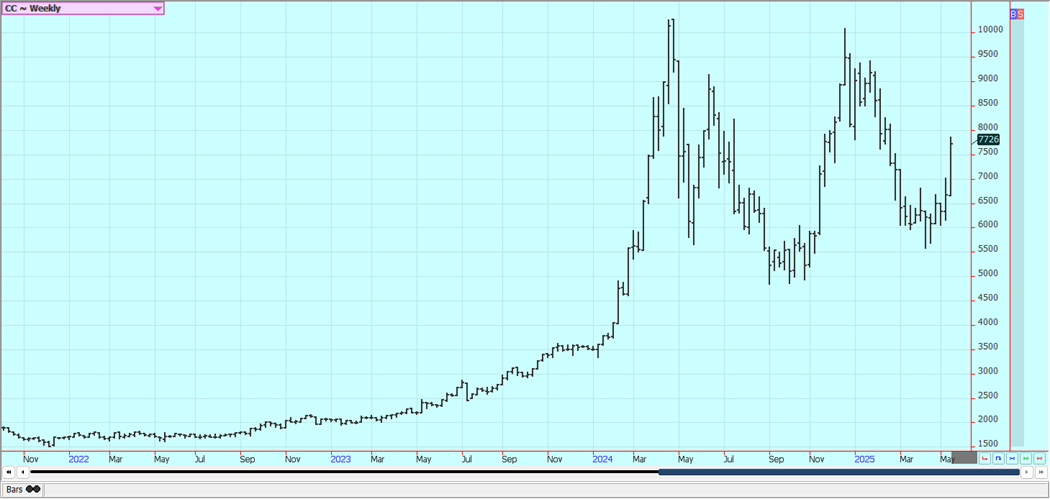Jack Scoville
Jack Scoville is an often quoted market analyst in the grain and soft commodities sectors. You will find his commentary throughout the Reuters, Wall Street Journal, Dow Jones, Bloomberg, and Barron's publications. Contact Mr. Scoville at (312) 264-4322
Translate





Weekly Ag Markets Update – 05/19/2025
Wheat: Minneapolis was much lower as rains moved into growing areas and the crop conditions showed significant improvement. Winter crops in the Great Plains are reported to be in good condition, but Spring Wheat crops in the northern Great Plains and into Canada have been dry. Temperatures should be much cooler in most growing areas this week. Chart trends are mixed. Enough Wheat has always been available to the market and demand for US Wheat in export markets has been poor. Dry outlooks for the Black Sea regions are still around. It is hot and dry in important parts of the EU and China. Overall demand for world Wheat has been weak.
Weekly Chicago Soft Red Winter Wheat Futures
Weekly Kansas City Hard Red Winter Wheat Futures
Weekly Minneapolis Hard Red Spring Wheat Futures
Corn: Corn was a little higher last week as the market reacted to better planting weather in the Midwest. Cooler and drier weather is in the forecast for the coming week after a arm week last week. The somewhat bullish USDA report released on Monday has had little effect on the price action so far this week. Demand for Corn in domestic and world markets remains strong with sales and shipments of above 1.6 million tons in the latest reporting week. It has been warmer and drier in much of the Midwest and planting progress is expected to be much improved this week. Oats were lower, and the trends are about steady in this market.
Weekly Corn Futures
Weekly Oats Futures
Soybeans and Soybean Meal: Soybeans and the products were higher in response to the release of the proposed EPA biofuels mandates. A sharp increase in the use of biofuels is desired by the agency. Export demand is in its seasonal doldrums. Brazil prices remain below those from the US in world markets as basis levels dropped there in response to the tariff news between the US and China. Export demand remains less for US Soybeans as China has been taking almost all the export from South America. Cooler temperatures and drier conditions are expected this week after az warm and wet late week last week.
Weekly Chicago Soybeans Futures
Weekly Chicago Soybean Meal Futures
Rice: Rice closed higher last week and might have reversed to a higher trend on the weekly charts. The cash market has been slow with mostly quiet domestic markets and average export demand. Export sales have not been strong, and domestic demand is not strong enough right now to bid prices any higher. Milling quality of the Rice remains below industry standards and it takes more Rough Rice to create the grain for sale to stores and exporters. Rice is planted in most growing areas now. Condition has been rated as good so far by private sources and USDA.
Weekly Chicago Rice Futures
Palm Oil and Vegetable Oils: Palm Oil futures were higher last week despite late week selling in response to weakness in Soybean Oil. Ideas of increasing production and reduced demand are still around. Chart trends are down. Canola was sharply lower last week on the price action in Chicago and forecasts for improved planting and development conditions in the Prairies. Trends are turning mixed on the daily charts and on the weekly charts. Canadian goods were exempted from the new round of tariffs but still must deal with the tariffs previously imposed by the US. The weather has generally been good for planting in the Prairies but it is too dry in some areas.
Weekly Malaysian Palm Oil Futures
Weekly Chicago Soybean Oil Futures
Weekly Canola Futures
Cotton: Cotton was lower again last week in response to improved weather conditions throughout the Cotton belt. The weekly export sales report showed below average demand. There are still reports of better weather for planting in the southern US and on demand concerns caused by the tariff wars and after USDA reported poor weekly export sales. Planting conditions remain good. Some rain was reported in west Texas last week, and farmers are in the fields. More showers are in the forecast for the Great Plains. It has turned drier in the Delta and Southeast. Planting progress is about the same as the five year average and conditions of the crops should be good.
Weekly US Cotton Futures
Frozen Concentrated Orange Juice and Citrus: Futures were mostly limit down Friday and closed a little lower for the week. Trends are mixed in the market. USDA adjusted US and Florida production slightly higher than in production estimates in its reports yesterday. Production estimates remain well below those from a year ago. The poor production potential for the crops comes from weather abut also the greening disease that has caused many Florida producers to lose trees. A tight market and higher prices should remain a feature for futures traders.
Weekly FCOJ Futures
Coffee: New York and London were lower last week in up and down price action. Trends turned down on the weekly charts. Prices are still very high overall and reflect the report of tight supplies and the production concerns in Latin America for Arabica production. The Brazil Robusta harvest started and Indonesia continues to harvest. Vietnam is done with its harvest.
Weekly New York Arabica Coffee Futures
Weekly London Robusta Coffee Futures
Sugar: Both markets were lower last week after failing to hold new highs in early week trading on ideas that the market will move to a surplus situation in the coming year. Ideas of good supplies and less demand continue. China has been a buyer with cheaper prices to help provide some support. Thai Sugar has moved to China lately and in volume. There were reports of some scattered showers in center south Brazil and the harvest has been slower. UNICA reported that sugar production had fallen almost 54% year on year to 856,160 tons.
Weekly New York World Raw Sugar Futures
Weekly London White Sugar Futures
Cocoa: New York and London were higher on concerns about West Africa production. There are still reports of increased flows of Cocoa from Nigeria and reports of increased production potential in other countries outside of West Africa, including Asia and Central America. The market anticipates good demand and less production from Ivory Coast and Ghana. Early pod counts for the 2025/26 main crop suggested there is unlikely to be a significant recovery in production next season. Mid crop counts have not been strong Trends are mixed in London and in New York but are trying to turn up even as demand ideas got hurt as the tariffs will increase costs to US buyers of chocolates. Demand ideas have been under pressure on the high prices currently seen for Cocoa due to bad production in West Africa. Cocoa imports are still subject to a 10% tariff at minimum.
Weekly New York Cocoa Futures
Weekly London Cocoa Futures

Questions? Ask Jack Scoville today at 312-264-4322